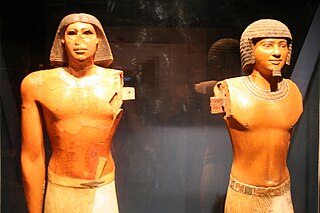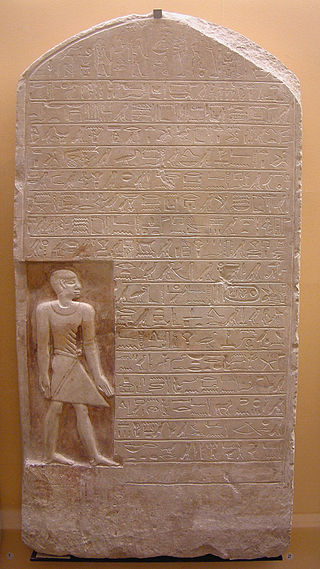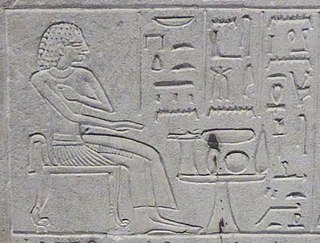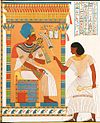Related Research Articles

A courtier is a person who attends the royal court of a monarch or other royalty. The earliest historical examples of courtiers were part of the retinues of rulers. Historically the court was the centre of government as well as the official residence of the monarch, and the social and political life were often completely mixed together.

A royal court, often called simply a court when the royal context is clear, is an extended royal household in a monarchy, including all those who regularly attend on a monarch, or another central figure. Hence, the word "court" may also be applied to the coterie of a senior member of the nobility. Royal courts may have their seat in a designated place, several specific places, or be a mobile, itinerant court.

The Middle Kingdom of Egypt is the period in the history of ancient Egypt following a period of political division known as the First Intermediate Period. The Middle Kingdom lasted from approximately 2040 to 1782 BC, stretching from the reunification of Egypt under the reign of Mentuhotep II in the Eleventh Dynasty to the end of the Twelfth Dynasty. The kings of the Eleventh Dynasty ruled from Thebes and the kings of the Twelfth Dynasty ruled from el-Lisht.

Sobekneferu or Neferusobek was a pharaoh of ancient Egypt and the last ruler of the Twelfth Dynasty of the Middle Kingdom. She ascended to the throne following the death of Amenemhat IV, possibly her brother or husband, though their relationship is unproven. Instead, she asserted legitimacy through her father Amenemhat III. Her reign lasted 3 years, 10 months, and 24 days, according to the Turin King List.

Ptahhotep, sometimes known as Ptahhotep I or Ptahhotpe, was an ancient Egyptian vizier during the late 25th century BC and early 24th century BC Fifth Dynasty of Egypt.

Smenkhkare Imyremeshaw was an Egyptian pharaoh of the mid 13th Dynasty during the Second Intermediate Period. Imyremeshaw reigned from Memphis, starting in 1759 BC or 1711 BC. The length of his reign is not known for certain; he may have reigned for five years and certainly less than ten years. Imyremeshaw is attested by two colossal statues now in the Egyptian Museum, Cairo.

Ankhu was an Egyptian vizier of the early 13th Dynasty, who lived around 1750 BC.
Ḥaty-a was an ancient Egyptian rank and title given to local princes, mayors, or governors.

Ancient Egyptian literature was written in the Egyptian language from ancient Egypt's pharaonic period until the end of Roman domination. It represents the oldest corpus of Egyptian literature. Along with Sumerian literature, it is considered the world's earliest literature.
The Treasurer in Ancient Egypt is the modern translation of the title imi-r ḫtmt. The office is known since the end of the Old Kingdom, where people with this title appear sporadically in the organization of private estates.

Neferkare Iymeru was the ancient Egyptian vizier under king Sobekhotep IV in the 13th Dynasty, in the Second Intermediate Period.

Senebi was an ancient Egyptian treasurer under the 13th Dynasty kings Neferhotep I and Sobekhotep IV. Senebi belongs to the best attested officials of the 13th Dynasty.

Sekhemre Sementawy Djehuti was possibly the second king of the Theban 16th Dynasty reigning over parts of Upper Egypt during the Second Intermediate Period. Alternatively, he may be a king of the late 13th Dynasty or the fourth king of the 17th Dynasty. Djehuty is credited with a reign of 3 years in the first entry of the 11th column of the Turin canon. According to Egyptologists Kim Ryholt and Darrell Baker, he was succeeded by Sobekhotep VIII.

The high steward was an important official at the royal court in Ancient Egypt in the Middle Kingdom and in the New Kingdom. He was the main person in charge of the estates supplying the palace and the royal residence with food. The office appears in the 11th Dynasty. To the earliest title holders belong Henenu and Meketre. After the vizier and the treasurer this was the most important office at the royal court; important title holders of the 12th Dynasty were Siese and Khnumhotep III, both were later in their career appointed vizier.

Menwadjre Sihathor was an ephemeral ruler of the 13th Dynasty during the late Middle Kingdom. Sihathor may never have enjoyed an independent reign, possibly only ruling for a few months as a coregent with his brother Neferhotep I.
Logariastes was a type of financial official in the Byzantine Empire from the early 11th century onwards, with the task of controlling expenses.
The overseer of the treasuries was an important official at the ancient Egyptian court of the Old and the New Kingdom. The title is first attested in the Fourth Dynasty. The title is not common in the Middle Kingdom, but is in the New Kingdom one of the most important ones at the royal court. The treasury was the place in the royal palace where precious materials were stored, such as metal objects, but also linen. Therefore, the overseer of the treasuries was basically responsible for administrating the resources of the country. The title is also attested in the Late Period. The writing of the title varies between ""overseer of the treasury" and "overseer of the two treasuries". It is not always clear whether this relates to different functions.
The Overseer of Upper Egypt was an important Ancient Egyptian title during the Old and Middle Kingdom periods. The title appears first in the early Fifth Dynasty. The first title holder is the vizier Kay, who possibly lived during the reigns of Neferirkare Kakai and Nyuserre Ini. The office is well attested in the following years. Most titles holders had other high titles, many of them were viziers. In the Fifth Dynasty, the Egyptian provinces became more important. The central government installed an office in charge of the provinces. The first title holders were all officials at the royal residence. In later times also local officials were bearing the title.
Resseneb was a short-lived vizier in Upper Egypt during the 13th Dynasty, preceded by his father, the famous Ankhu, and succeeded by his brother Iymeru.
The royal sealer or royal seal-bearer was an Ancient Egyptian official position and title. The name literally means "sealer of the king of Lower Egypt," but it seems unlikely that the position was ever geographically limited. In the Early Dynastic period and Old Kingdom, it was one of the most important positions in Egypt. The bearer seems to have headed the treasury and had significant symbolic power as an official representative of the Pharaoh. As a "ranking title," it indicated the bearer's pre-eminence in court. In the late Middle Kingdom, it was revived as a ranking title borne by many of the highest officials in the court. This apparently coincided with an increased prominence of seals in the Egyptian administration, as part of a centralisation of the bureaucracy. The title spread more widely in the Second Intermediate period, diluting its power.
References
- ↑ Stephen Quirkeː Titles and bureaux, London 2004, ISBN 0954721802, p. 91
- ↑ Julien Siesse: La XIIIe dynastie: histoire de la fin du Moyen Empire égyptien. Passé présent. Sorbonne Université, Paris 2019, ISBN 979-10-231-0567-4, pp. 183-193.
- ↑ Quirkeː Titles and bureaux, 91-92
